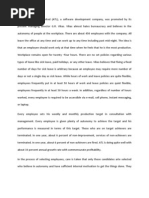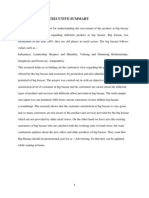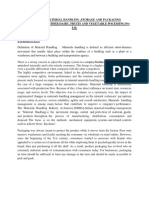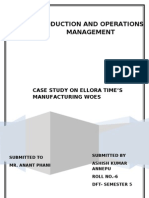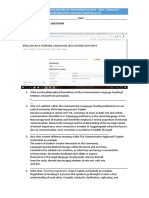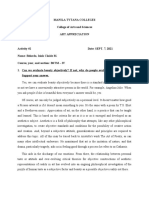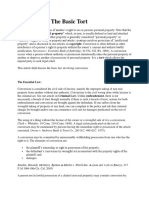"A Study On Inventory Management" Statement of Problem
Uploaded by
Sandhiya Govind"A Study On Inventory Management" Statement of Problem
Uploaded by
Sandhiya GovindA STUDY ON INVENTORY MANAGEMENT STATEMENT OF PROBLEM A study of inventory management at ABB LTD is undertaken in order to know the inventory
performance and position of the company and to know the strength and weakness and to assess the profitability of the company. Inventories constitute most significant part of assets of large majority of the companies in India. Inventory a double edged sword is usually an asset of an organization, if not used properly it will become liability. It is therefore absolutely very important to manage inventories efficiently and effectively in order to overcome unnecessary investment. And To identify the problems/challenges involved in the Inventory Management process at ABB ltd. OBJECTIVES OF THE STUDY The main objectives of the study are:OBJECTIVES: 1. To study the tools and techniques of inventory management adopted at ABB Ltd. 2. To study the inventory control measures in inventory management. 3. To study the demand forecast of inventory management at ABB Ltd. 4. To study how ABC analysis and aging schedule is implemented in inventory management. 5. To determine the stock level in inventory management at ABB Ltd. 6. To identify problems related to inventory management and to find out suitable measures to overcome them. 7. To study the methods of valuation of inventory on ABB Ltd. 8. To study the inventory management procedure. 9. To make a comparative study of inventory management in last 5 years using ratio analysis technique. Methodology of data collection a) Primary data The primary data is collected by personal interviews with officials. b) Secondary data Files, annual reports, periodicals, manuals and text book. Which have already been passed through the statistical process are the secondary data used. c) Field work This was under taken individually to collect various information regarding the study by visiting following sections. Stores department Information regarding stocking of materials receipts and issues to workshops. Inventory control procedures in various wards inside the department were obtained. Accounts department Remaining all the information was obtained from accounts department through personal interviews with section officials. Plan of analysis The analysis and interpretation was collected from finance department thus processed and
tabulated is in the form of tables and graphs. The table thus obtained by calculating average, percentage, turnover ratio, graphs and diagram in respect of the stock of raw materials sales & inventory control procedures and thus to draw conclusion from the analysis done. Scope of the study This study is to find the facts and opinions of inventory management and control at ABB plant. In accordance with the present trends it aims mainly at finding out the inventory control procedures at ABB. This study gives the brief information about the inventory management of the indo ABB ltd The study was done by using annual reports, inventory manualetc. Limitation of the study Time restriction was only 30 days of project work in the organization. The information, which was needed, could not be made public by the organization. The study are related to ABB ltd Bangalore only The finding and suggestion cannot be generalized. The study covered a wide concept hence wide collection and coverage of information was not easily possible. Reference: http://seminarprojects.com/Thread-inventory-management#ixzz1x1FrVIrF
INTRODUCTION TO INVENTORY MANAGEMENT Inventory is a list for goods and materials, or those goods and materials themselves, held available in stock by a business. Inventory are held in order to manage and hide from the customer the fact that manufacture/supply delay is longer than delivery delay, and also to ease the effect of imperfections in the manufacturing process that lower production efficiencies if production capacity stands idle for lack of materials. The most important objective or inventory control is to determine and maintain an optimum level of investment in the inventory. Most companies have now successfully installed one or the other system of inventory planning and control. Inventory Management and Inventory Control must be designed to meet the dictates of the marketplace and support the company's strategic plan. The many changes in market demand, new opportunities due to worldwide marketing, global sourcing of materials, and new manufacturing technology, means many companies need to change their Inventory Managementapproach and change the process for Inventory Control. Despite the many changes that companies go through, the basic principles of Inventory Management and Inventory Control remain the same. Some of the new approaches and techniques are wrapped in new terminology, but the underlying principles for accomplishing good Inventory Management and Inventory activities have not changed.
The Inventory Management system and the Inventory Control Process provides information to efficiently manage the flow of materials, effectively utilize people and equipment, coordinate internal activities, and communicate with customers. Inventory Management and the activities of Inventory Control do not make decisions or manage operations; they provide the information to Managers who make more accurate and timely decisions to manage their operations. The basic building blocks for the Inventory Management system and Inventory Control activities are: Sales Forecasting or Demand Management Sales and Operations Planning Production Planning Material Requirements Planning Inventory Reduction The emphases on each area will vary depending on the company and how it operates, and what requirements are placed on it due to market demands. Each of the areas above will need to be addressed in some form or another to have a successful program of Inventory Management and Inventory Control. NEED TO HOLD THE INVENTORIES There are the four major reason for holding inventories. 1. TRANSACTION PURPOSE : Which emphasized the need to maintain inventories to smoothen production and sales operations, which is for the day-to-day use. 2. SAFETY PURPOSE : Which necessities holding of inventories to guard against the risk of unpredictable changes in the market. 3. SPECULATIVE PUROSE : There is a speculative element which influences the decision to increase or decrease Inventory levels to take advantage of price change. TYPES OF INVENTORIES : Inventories can be classified in terms of its different uses, which will enable one to appreciate the peculiarities and problems in its uses. Secondly the differentiation based on uses of inventories will enable one to adopt control techniques to suit the needs Inventories are classified according to uses and point of entry in the alteration is as follows: 1. Raw Material 2. Spares and Consumables 3. Work in Process Goods and 4. Finished Goods Reference: http://seminarprojects.com/Thread-inventory-management#ixzz1x1G0nynd
You might also like
- Provisional Academic Transcript: Bachelor of Arts100% (4)Provisional Academic Transcript: Bachelor of Arts2 pages
- Othm Level 6 Certificate IN Occupational Health AND Safety: Qualification Ref. No.: 603/5218/867% (6)Othm Level 6 Certificate IN Occupational Health AND Safety: Qualification Ref. No.: 603/5218/846 pages
- A Study On Inventory Management and Control: Pratap Chandrakumar. R Gomathi ShankarNo ratings yetA Study On Inventory Management and Control: Pratap Chandrakumar. R Gomathi Shankar9 pages
- Industrial Distribution Channels Marketing Logistics100% (1)Industrial Distribution Channels Marketing Logistics13 pages
- A Study On Inventory Management at Anantha PVC Pipes PVT LTD, AnanthapurNo ratings yetA Study On Inventory Management at Anantha PVC Pipes PVT LTD, Ananthapur8 pages
- Supply Chain Management Mba (MM) Iii SemNo ratings yetSupply Chain Management Mba (MM) Iii Sem43 pages
- Distribution Network Design in Practice - 2015083 - 2015054 - SCM - BNo ratings yetDistribution Network Design in Practice - 2015083 - 2015054 - SCM - B7 pages
- The Impact of Working Capital Management On The Performance of Food and Beverages IndustryNo ratings yetThe Impact of Working Capital Management On The Performance of Food and Beverages Industry6 pages
- Costing and Cost Reduction OF Rotary Air Lock Valve: Sneha IndustriesNo ratings yetCosting and Cost Reduction OF Rotary Air Lock Valve: Sneha Industries55 pages
- Britannia Industries - Inventory Management PracticesNo ratings yetBritannia Industries - Inventory Management Practices35 pages
- Abhi - Introduction Scope and Historical Background of SCM100% (1)Abhi - Introduction Scope and Historical Background of SCM22 pages
- S.amutha A Study On Inventory Management in Izon Technologies Ramco Cement LimitedNo ratings yetS.amutha A Study On Inventory Management in Izon Technologies Ramco Cement Limited30 pages
- A Study On Consumer Perception Towards Multiplex Theatre - With Special Reference To Coimbatore CityNo ratings yetA Study On Consumer Perception Towards Multiplex Theatre - With Special Reference To Coimbatore City4 pages
- Chapter - 1: A Study On Inventory Management at Precot Meridian LTD HindupurNo ratings yetChapter - 1: A Study On Inventory Management at Precot Meridian LTD Hindupur76 pages
- Bharat Petroleum Corporation Limited: DiagnosesNo ratings yetBharat Petroleum Corporation Limited: Diagnoses11 pages
- Inventory Management - Industry Profile ProjectNo ratings yetInventory Management - Industry Profile Project76 pages
- Unit 1 Understanding Quality - 1quality, Competitiveness and CustomersNo ratings yetUnit 1 Understanding Quality - 1quality, Competitiveness and Customers3 pages
- Pagadian Montessori Center, Inc. Urro Street, Sta. Maria District, Pagadian CityNo ratings yetPagadian Montessori Center, Inc. Urro Street, Sta. Maria District, Pagadian City1 page
- Operator'S Manual: KP-6299C/8299C/1299CNo ratings yetOperator'S Manual: KP-6299C/8299C/1299C83 pages
- Part I. Geometric Design: II. A. Horizontal Curve 1No ratings yetPart I. Geometric Design: II. A. Horizontal Curve 19 pages
- Discuss The Scope of Engineering Ethics With ExampleNo ratings yetDiscuss The Scope of Engineering Ethics With Example14 pages
- Communicative Language Teaching WorksheetNo ratings yetCommunicative Language Teaching Worksheet3 pages
- Submitted By:: Tarnate, Hazel R. Bsba - 4B Submitted To: Professor Renilda MartinezNo ratings yetSubmitted By:: Tarnate, Hazel R. Bsba - 4B Submitted To: Professor Renilda Martinez28 pages
- Differentiated Instruction in Relation To Pupils' Learning StyleNo ratings yetDifferentiated Instruction in Relation To Pupils' Learning Style15 pages
- Study Methods For Improving Quality Learning and P100% (1)Study Methods For Improving Quality Learning and P7 pages
- Personal Development: Quarter 2 - Module 4: Family StructuresNo ratings yetPersonal Development: Quarter 2 - Module 4: Family Structures25 pages
- Questionnaire Survey Research What Works 2nd EditionNo ratings yetQuestionnaire Survey Research What Works 2nd Edition217 pages
























